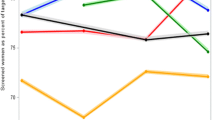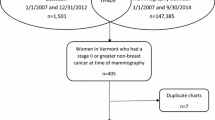Abstract
OBJECTIVES: The impact of false positives on breast cancer screening retention is inconsistent across international studies. We investigate factors associated with screening retention, including false positive screening results, invasiveness of diagnostic procedures, and geographic variation in Alberta, Canada.
METHODS: A total of 213 867 women aged 50–67 years who had an index screen mammogram between July 2006 and June 2008 were evaluated at 30 months post index screen to determine the screening retention rate. The association of screening retention with invasiveness of the diagnostic procedure, time to diagnostic resolution, and region of residence were investigated using multivariable log binomial regression, adjusting for women’s age.
RESULTS: Women with false positive screening results were less likely to return for their next recommended screening than those with a true negative result (62.0% vs. 68.7%). Compared to women with normal screening results, the adjusted risk ratios of fail-to-rescreen for women with imaging-only follow-up, needle sampling, and open biopsy were 1.08 (95% CI: 1.05–1.12), 1.72 (95% CI: 1.44–2.07) and 2.29 (95% CI: 2.09–2.50) respectively. Screening retention rates were slightly higher for rural residents than urban residents. Time to diagnostic resolution was not associated with screening retention. Screening retention peaked at one year from the index date of the previous screening.
CONCLUSION: Higher awareness of the strong negative impact that biopsies in the case of a false positive screening have on screening retention is needed. Such awareness can inform intervention strategies to mitigate the impact and improve screening retention rate.
Résumé
OBJECTIFS: L’incidence des faux positifs sur la fidélisation au dépistage du cancer du sein varie dans les études internationales. Nous étudions les facteurs associés à la fidélisation au dépistage en Alberta, au Canada, dont les résultats faux positifs au dépistage, le caractère invasif de la méthode diagnostique et la variation spatiale.
MÉTHODE: En tout, 213 867 femmes de 50 à 67 ans ayant subi une mammographie de dépistage indicielle entre juillet 2006 et juin 2008 ont été évaluées 30 mois après pour déterminer le taux de fidélisation au dépistage. Les associations entre la fidélisation au dépistage et le caractère invasif de la méthode diagnostique, le délai de résolution du diagnostic et la région de résidence ont été étudiées par régression log-binomiale multivariée avec ajustement en fonction de l’âge des femmes.
RÉSULTATS: Les femmes ayant obtenu des résultats faux positifs au dépistage étaient moins susceptibles de retourner subir leur prochain dépistage recommandé que celles ayant obtenu des résultats vrais négatifs (62,0 % c. 68,7 %). Comparativement aux femmes ayant obtenu des résultats normaux au dépistage, les risques relatifs ajustés des femmes n’ayant pas subi un dépistage ultérieur étaient de 1,08 (IC de 95 %: 1,05–1,12) pour le suivi avec imagerie seulement, de 1,72 (IC de 95 %: 1,44–2,07) pour le prélèvement à l’aide d’une aiguille et de 2,29 (IC de 95 %: 2,09–2,50) pour la biopsie ouverte. Les taux de fidélisation au dépistage étaient légèrement plus élevés chez les résidentes des zones rurales que chez celles des zones urbaines. Le délai de résolution du diagnostic n’était pas associé à la fidélisation au dépistage. La fidélisation au dépistage a culminé un an après la date indicielle du dépistage précédent.
CONCLUSION: Il est nécessaire d’être plus sensibilisé à l’effet très nuisible des biopsies sur la fidélisation au dépistage en cas de résultats faux positifs. Une telle sensibilisation peut éclairer les stratégies d’intervention pour atténuer cet effet et améliorer les taux de fidélisation au dépistage.
Similar content being viewed by others
References
Canadian Task Force on Preventive Health Care, Tonelli M, Connor Gorber S, Joffres M, Dickinson J, Singh H, et al. Recommendations on screening for breast cancer in average-risk women aged 40–74 years. CMAJ 2011; 183(17):1991–2001. PMID: 22106103. doi: 10.1503/cmaj.110334.
US Preventive Services Task Force. Screening for breast cancer: U.S. Preventive Services Task Force recommendation statement. Ann Intern Med 2009; 151(10):716–26, W-236. PMID: 19920272. doi: 10.7326/0003-4819-151-10-200911170-00008.
Altobelli E, Lattanzi A. Breast cancer in European Union: An update of screening programmes as of March 2014 (review). Int J Oncol 2014; 45(5):1785–92. PMID: 25174328. doi: 10.3892/ijo.2014.2632.
Duffy SW, Tabar L, Olsen AH, Vitak B, Allgood PC, Chen TH, et al. Absolute numbers of lives saved and overdiagnosis in breast cancer screening, from a randomized trial and from the Breast Screening Programme in England. J Med Screen 2010;17(1):25–30. PMID: 20356942. doi: 10.1258/jms.2009.009094.
Nyström L, Andersson I, Bjurstam N, Frisell J, Nordenskjöld B, Rutqvist LE. Long-term effects of mammography screening: Updated overview of the Swedish randomised trials. Lancet 2002;359(9310):909–19. PMID: 11918907. doi: 10.1016/S0140-6736(02)08020-0.
Maxwell AJ, Beattie C, Lavelle J, Lyburn I, Sinnatamby R, Garnett S, et al. The effect of false positive breast screening examinations on subsequent attendance: Retrospective cohort study. J Med Screen 2013;20(2):91–98. PMID: 24009091. doi: 10.1177/0969141313499147.
Brodersen J, Siersma VD. Long-term psychosocial consequences of false-positive screening mammography. Ann Earn Med 2013;11(2):106–15. PMID: 23508596. doi: 10.1370/afm.l466.
Canadian Partnership Against Cancer. Organized Breast Cancer Screening Programs in Canada: Report on Program Performance in 2007 and 2008. Toronto, ON: Canadian Partnership Against Cancer, 2013.
Nelson HD, O’Meara ES, Kerlikowske K, Balch S, Miglioretti D. Factors associated with rates of false-positive and false-negative results from digital mammography screening: An analysis of registry data. Ann Intern Med 2016; 164(4):226–35. PMID: 26756902. doi: 10.7326/M15-0971.
Brewer NT, Salz T, Lillie SE. Systematic review: The long-term effects of false-positive mammograms. Ann Intern Med 2007;146(7):502–10. PMID: 17404352.
Johnson MM, Hislop TG, Kan L, Coldman AJ, Lai A. Compliance with the screening mammography program of British Columbia: Will she return? Can J Public Health 1996;87(3):176–80. PMID: 8771920.
Chiarelli AM, Moravan V, Halapy E, Majpruz V, Mai V, Tatla RK. False-positive result and reattendance in the Ontario Breast Screening Program. J Med Screen 2003;10(3):129–33. PMID: 14561264.
Public Health Agency of Canada. Organized Breast Cancer Screening Programs in Canada - Report on Program Performance in 2005 and 2006. Ottawa, ON: PHAC, 2011.
Alberta Society of Radiologists. What is the Alberta Society of Radiologists (ASK)?. Available at: http://www.radiologists.ab.ca (Accessed September 1, 2016).
Taylor K, Britton P, O’Keeffe S, Wallis M. Quantification of the UK 5-point breast imaging classification and mapping to BI-RADS to facilitate comparison with international literature. Br J Radiol 2014;84(1007):1005–10. doi: 10. 1259/bjr/48490964.
Alberta Health Services Cancer Screening Programs. Bringing Good Breast Health to You. Calgary, AB: Alberta Health Services Cancer Screening Programs. Available at: http://screeningforlife.ca/screentest (Accessed September 1, 2016).
Towards Optimal Practice (TOP) Working Group for Breast Cancer Screening. Breast Cancer Screening: Clinical Practice Guideline. Edmonton, AB: Toward Optimized Practice, 2013. Available at: http://www.topalbertadoctors.org (Accessed September 1, 2016).
Percy C, Muir CS, Holten W, World Health Organization. International Classification of Diseases for Oncology. Geneva, Switzerland: WHO, 1990.
Yuan Y, Li M, Yang J, Winget M. Using administrative data to estimate time to breast cancer diagnosis and percent of screen-detected breast cancers - A validation study in Alberta, Canada. Eur J Cancer Care 2015;24(3):367–75. PMID: 25521706. doi: 10.1111/ecc.l2277.
Canadian Partnership Against Cancer. Report From the Evaluation Indicators Working Group: Guidelines for Monitoring Breast Cancer Screening Program Performance, 3rd ed. Toronto, ON: Canadian Partnership Against Cancer, 2013.
Chiarelli AM, Halapy E, Nadalin V, Shumak R, O’Malley F, Mai V. Performance measures from 10 years of breast screening in the Ontario Breast Screening Program, 1990/91 to 2000. Eur J Cancer Prev 2006;15(1): 34–42. PMID: 16374227.
Alamo-Junquera D, Murta-Nascimento C, Macia F, Bare M, Galceran J, Ascunce N, et al. Effect of false-positive results on reattendance at breast cancer screening programmes in Spain. Eur J Public Health 2012;22(3):404–8. PMID: 21558152. doi: 10.1093/eurpub/ckr057.
Bond M, Pavey T, Welch K, Cooper C, Garside R, Dean S, et al. Systematic review of the psychological consequences of false-positive screening mammograms. Health Technol Assess 2013;17(13):1–170, v-vi. PMID: 23540978. doi: 10.3310/hta17130.
Bond M, Pavey T, Welch K, Cooper C, Garside R, Dean S, et al. Psychological consequences of false-positive screening mammograms in the UK. Evid Based Med 2013;18(2):54–61. PMID: 22859786. doi: 10.1136/eb-2012-100608.
Drossaert CH, Boer H, Seydel ER. Monitoring women’s experiences during three rounds of breast cancer screening: Results from a longitudinal study. J Med Screen 2002;9(4):168–75. PMID: 12518007. doi: 10.1136/jms.9.4.168.
Gur D, Sumkin JH, Hardesty LA, Clearfield RJ, Cohen CS, Ganott MA, et al. Recall and detection rates in screening mammography. Cancer 2004; 100(8):1590–94. PMID: 15073844. doi: 10.1002/cncr.20053.
White E, Miglioretti DL, Yankaskas BC, Geller BM, Rosenberg RD, Kerlikowske K, et al. Biennial versus annual mammography and the risk of late-stage breast cancer. J Natl Cancer Inst 2004;96(24):1832–39. PMID: 15601639. doi: 10.1093/jnci/djh337.
Jibaja-Weiss ML, Volk RJ, Kingery P, Smith QW, Holcomb JD. Tailored messages for breast and cervical cancer screening of low-income and minority women using medical records data. Patient Educ Couns 2003;50(2):123–32. PMID: 12781927.
Taplin SH, Barlow WE, Ludman E, MacLehos R, Meyer DM, Seger D, et al. Testing reminder and motivational telephone calls to increase screening mammography: A randomized study. J Natl Cancer Inst 2000;92(3):233–42. PMID: 10655440.
Alberta Health Services. Alberta Health Services Annual Report 2015–2016. Edmonton, AB: Alberta Health Services, 2016.
Statistics Canada. Table 051-0001 -Estimates of population, by age group and sex for July 1, Canada, provinces and territories, annual, CANSIM (database). Ottawa, ON: Statistics Canada, 2016.
Vahabi M, Lofters A, Kumar M, Glazier RH. Breast cancer screening disparities among urban immigrants: A population-based study in Ontario, Canada. BMC Public Health 2015;15:679. PMID: 26194189. doi: 10.1186/sl2889-015-2050-5.
Author information
Authors and Affiliations
Corresponding author
Additional information
Conflict of Interest: None to declare.
Rights and permissions
About this article
Cite this article
Shen, Y., Winget, M. & Yuan, Y. The impact of false positive breast cancer screening mammograms on screening retention: A retrospective population cohort study in Alberta, Canada. Can J Public Health 108, e539–e545 (2017). https://doi.org/10.17269/CJPH.108.6154
Received:
Accepted:
Published:
Issue Date:
DOI: https://doi.org/10.17269/CJPH.108.6154




